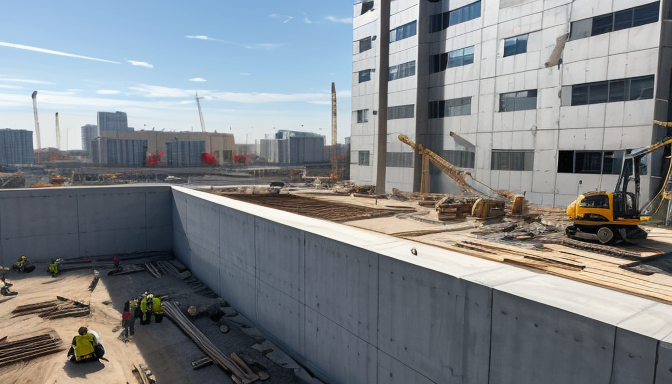Welcome to the exciting realm of self-healing materials, a breakthrough that’s revolutionizing the construction industry! Imagine a world where buildings can mend their own cracks and damages, much like how our skin heals when we get a cut. Isn’t that a fascinating thought? These materials have the potential to not only enhance the longevity of structures but also significantly reduce maintenance costs.
At the heart of this innovation lies a unique blend of chemistry and technology. Self-healing materials contain microcapsules filled with healing agents that are released when the material is damaged. This process mimics natural healing and can be applied to a variety of construction materials such as concrete and asphalt. The implications are staggering! With these materials, we could see a significant reduction in the need for repairs and replacements, which in turn could lead to fewer resources being consumed.
But how are these materials being utilized in real-world applications? From highways that can recover from wear and tear to bridges that can self-repair after sustaining damage, the possibilities are endless. For instance, researchers are experimenting with self-healing concrete that can fill in cracks autonomously, enhancing the durability of structures exposed to harsh weather conditions.
As we delve deeper into the benefits, it’s essential to recognize that self-healing materials not only promise cost-effectiveness but also contribute to a more sustainable future. By minimizing the frequency of repairs, we reduce waste and lower the carbon footprint associated with construction activities. In essence, these materials are not just a trend; they are a pivotal step toward a more resilient and environmentally friendly construction industry.
The Science Behind Self-Healing Materials
Ever wondered how some materials can magically repair themselves? The science behind self-healing materials is nothing short of fascinating and is paving the way for revolutionary changes in construction. At its core, self-healing materials are designed to mimic biological processes, much like how our skin heals after a cut. This is achieved through innovative chemistry and engineering techniques that enable these materials to respond to damage.
Self-healing materials typically contain microcapsules filled with healing agents. When a crack or a scratch occurs, these microcapsules rupture, releasing the healing agents into the damaged area. This process can be likened to a first-aid kit that springs into action as soon as an injury occurs. The healing agents then react chemically to form a solid bond, effectively sealing the damage. This not only restores the material’s integrity but also enhances its longevity.
To better understand how these materials work, let’s break down the key components:
- Microcapsules: Tiny spheres that contain healing agents.
- Healing Agents: Substances that react to form a solid material when released.
- Polymer Matrix: The surrounding material that holds everything together and supports the healing process.
One of the most exciting aspects of self-healing materials is their potential to reduce maintenance costs and extend the lifespan of structures. Imagine a bridge that can fix itself after minor damage, or a building that can withstand the wear and tear of time without constant repairs. The implications are enormous, and as research progresses, we can expect to see even more sophisticated self-healing technologies emerging in the construction industry.

Applications in Modern Construction
Self-healing materials are revolutionizing the construction industry, offering innovative solutions that enhance the longevity and resilience of structures. Imagine a building that can literally “heal” itself from cracks and damage—sounds like something out of a sci-fi movie, right? But this technology is very much a reality today. These materials are being integrated into a variety of construction projects, transforming how we think about maintenance and durability.
One of the most exciting applications of self-healing materials is in bridges. These structures are constantly exposed to the elements and heavy loads, making them susceptible to wear and tear. By incorporating self-healing concrete, engineers can significantly reduce maintenance costs and extend the lifespan of bridges. For instance, if a small crack appears, the embedded healing agents within the concrete can activate and fill the damage, preventing further deterioration.
Moreover, self-healing materials are making their way into high-rise buildings. With the increasing height of skyscrapers, the stress on materials is immense. Self-healing coatings can be applied to glass and steel surfaces to protect them from scratches and environmental damage. This not only preserves the aesthetic appeal of these structures but also minimizes the need for costly repairs.
Additionally, self-healing technologies are being explored in the realm of roadways. Imagine driving on a road that can repair itself after potholes form! Researchers are experimenting with self-healing asphalt, which could lead to safer and more sustainable road maintenance practices. This innovation could save municipalities millions in repair costs while enhancing driver safety.
As we continue to explore the possibilities of self-healing materials, it’s clear that their applications in modern construction are just beginning to scratch the surface. The potential for these materials to change the way we build and maintain infrastructure is immense, paving the way for a more sustainable future.
Benefits of Self-Healing Materials
When it comes to construction, self-healing materials are nothing short of a game-changer. Imagine a world where your buildings and infrastructure can literally fix themselves when damaged! This innovative technology not only enhances the longevity of structures but also significantly reduces maintenance costs. In fact, studies suggest that self-healing materials can cut down repair expenses by up to 30% over the lifespan of a building. Isn’t that incredible?
One of the standout benefits of these materials is their durability. Traditional construction materials can suffer from wear and tear, leading to cracks and structural weaknesses. However, self-healing materials are designed to react to damage. For instance, when a crack forms, microcapsules embedded in the material release healing agents that bond and restore the integrity of the structure. This not only prolongs the life of the material but also enhances the overall safety of the construction.
Moreover, self-healing materials are also environmentally friendly. By reducing the frequency of repairs and the need for replacement materials, they contribute to lower waste generation. This sustainability aspect is becoming increasingly important in today’s eco-conscious world. In fact, using these materials can lead to a significant decrease in the carbon footprint associated with construction activities.
In summary, the benefits of self-healing materials are numerous and profound. They offer cost-effectiveness, enhanced durability, and a positive environmental impact. As the construction industry continues to evolve, embracing these innovative materials may very well be the key to a more sustainable and efficient future.

Challenges and Limitations
While the idea of self-healing materials sounds like something straight out of a sci-fi movie, the reality is that there are challenges and limitations that come with their integration into the construction industry. First off, let’s talk about cost. Developing these materials often requires advanced technology and research, which can drive up initial costs. For many construction companies operating on tight budgets, this can be a significant barrier. Imagine wanting to build a bridge that repairs itself, but the price tag makes you think twice!
Another hurdle is the performance consistency. Not all self-healing materials are created equal. Some may work wonderfully in lab conditions but fail to deliver in real-world scenarios. This inconsistency can lead to skepticism among builders and investors alike. Would you want to rely on a material that might not perform as expected when it’s holding up a skyscraper?
Moreover, there’s the question of regulatory approval. The construction industry is heavily regulated, and introducing new materials often means navigating a complex web of standards and certifications. This can slow down the adoption process significantly. Time is money, and delays in getting these materials approved can be a dealbreaker for many projects.
Lastly, while self-healing materials offer exciting possibilities, they also require a shift in how we think about maintenance and repair. Traditional methods may not be compatible with these innovative materials, leading to a learning curve for construction professionals. As with any groundbreaking technology, embracing change can be a tough pill to swallow.
In summary, while self-healing materials have the potential to revolutionize construction, overcoming these challenges is essential for their widespread acceptance. The journey may be difficult, but the destination could lead to a future where buildings are not just structures but resilient entities that can heal themselves.
Future Trends in Self-Healing Technology
As we look ahead, the landscape of self-healing technology in construction is brimming with exciting possibilities. Imagine a world where buildings can autonomously mend their own cracks and damages, significantly extending their lifespan and reducing maintenance costs. This is not just a dream; it’s becoming a reality thanks to rapid advancements in materials science and engineering.
One of the most promising trends is the integration of smart materials that respond to environmental stimuli. These materials can sense damage and initiate the healing process without human intervention. For instance, researchers are developing polymers infused with microcapsules containing healing agents that are released when a crack occurs. This self-initiated repair mechanism could revolutionize how we approach building maintenance.
Additionally, there is a growing emphasis on sustainability in self-healing materials. Many new formulations are being designed to be environmentally friendly, using bio-based or recycled materials. This not only reduces the carbon footprint of construction projects but also aligns with global efforts to promote sustainable practices. In fact, a recent study highlighted that the use of self-healing concrete could lead to a 20% reduction in CO2 emissions compared to traditional materials.
Moreover, the future of self-healing technology is likely to see enhanced collaboration between various sectors, including construction, nanotechnology, and robotics. This interdisciplinary approach could lead to breakthroughs that we can hardly imagine today. For example, integrating AI with self-healing materials may allow structures to learn from their environment and adapt over time, making them even more resilient.
In conclusion, the future trends in self-healing technology are not just about repairing materials; they represent a paradigm shift in how we construct and maintain our built environment. As these innovations continue to evolve, we can expect to see safer, more durable, and environmentally friendly buildings that can withstand the test of time.
Frequently Asked Questions
- What are self-healing materials?
Self-healing materials are innovative substances that can automatically repair damage without human intervention. Imagine a scratch on your phone that disappears on its own—this is the essence of self-healing materials in construction!
- How do self-healing materials work?
These materials typically contain microcapsules filled with healing agents. When a crack occurs, the capsules break open, releasing the agents that bond the material back together. It’s like a superhero swooping in to fix a problem!
- What are the benefits of using self-healing materials in construction?
Using self-healing materials can significantly reduce maintenance costs, extend the lifespan of structures, and enhance safety. Plus, they can lessen the environmental impact by reducing the need for repairs and replacements.
- Are there any challenges in adopting self-healing materials?
Yes, while the potential is exciting, challenges such as cost, scalability, and regulatory approval can hinder widespread use. It’s like having a fantastic idea but needing to navigate some roadblocks before it can take off!
- What does the future hold for self-healing materials?
The future looks bright! Ongoing research and technological advancements are expected to enhance their effectiveness and integration into construction practices, paving the way for smarter and more resilient buildings.

